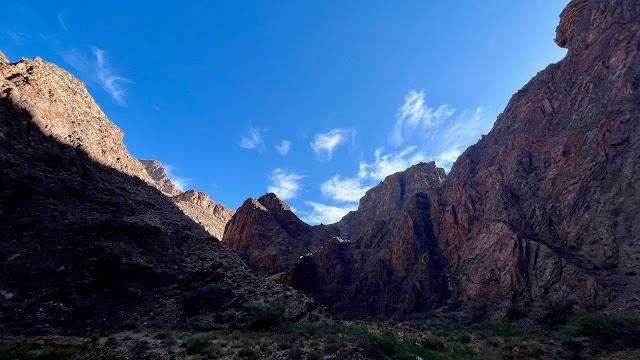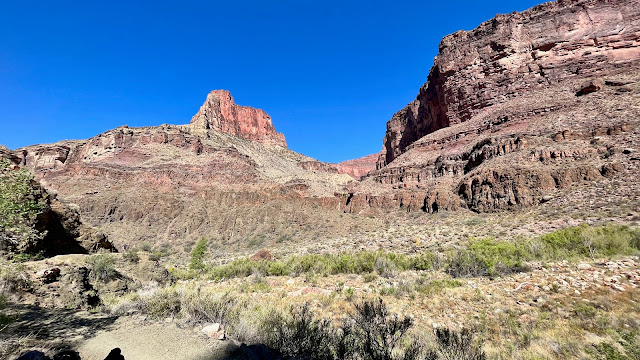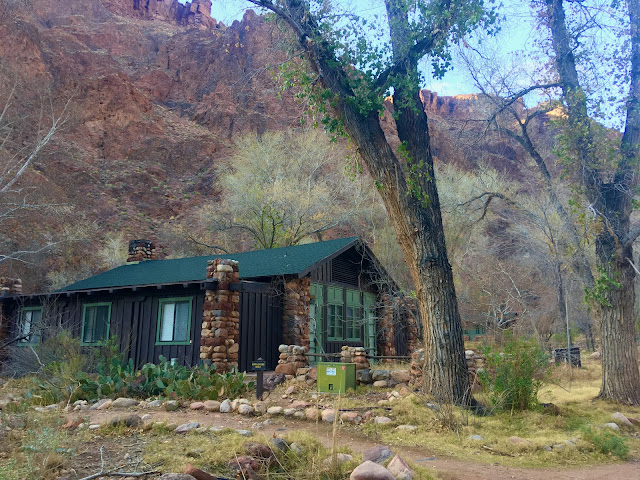Today, I get to take an easy eight-mile trip along the Bright Angel Creek, and through a potential oven known ominously as The Box, as it wends its way through Bright Angel Canyon on its way through the verdant Cottonwood Campground, where I’ll be spending the next two nights. But first, a little geology.
Note: If you’re a young-earth creationist, and believe the Grand Canyon was formed by Noah’s flood over a 5,000 year period, you might want to stop reading now. While there is disagreement as to how and when the canyon was carved, everyone in science agrees the canyon is at least 6 million years old.
The last shallow sea to inhabit this area subsided some 80 million years ago, and the first uplift of the Colorado Plateau began around 70 million years ago, followed by two later uplifts. The plateau uplifted at an angle, the north higher than the south creating a slope, and then with the canyon carved out, left the north rim almost 1,500 feet higher in elevation than the south rim. This will be of more import tomorrow when I hike up to the North Rim.
No one really knows the exact age of the Grand Canyon, or precisely how it was carved (some combination of headward erosion, karst rock collapse, basin over flow, and plateau uplift), but most scientists agree that the Colorado River, or some ancestor river, carved the canyon. The age of the canyon ranges from 70 million years old, to around 6 million years old, with a majority of scientists leaning toward the younger age.
Muddying the water, is evidence the Colorado River, or some other antecedent river system, flowed northeast as opposed to southwest, and that an ancestor canyon might have been carved at a much earlier date.
There is also debate whether the canyon was formed quickly, or over a long period of time, but the recent evidence suggests that after Colorado River became integrated into the river system we see today —5 or 6 million years ago—the real work of carving began and the canyon became significantly deeper and wider within the last 4 million years. Because of the many unconformities and gaps in the geologic record, the precise way it unfolded aren’t known. However, it was some combination of uplift and erosion.
The last major event to happen in the canyon, within the last 700 thousand years, was the eruption of cataclysmic basalt lava flows into the canyon from the walls and down from the rims, creating basalt dams that, when they failed, often spectacularly, unleashed cascades of massive abrading materials to further accelerate the carving of the canyon and further complicate the often sketchy geologic record.
 |
| Phantom Ranch cabins. |
 |
I got up at 4:30 for 5:00 breakfast at the Phantom Ranch Canteen. I reserved four meals in all, dinner last night, breakfast today, and then another dinner and breakfast when I return to Bright Angel Campground in three days. It’s not that I love the food, although the vegetarian chili ain’t half bad; it’s because these are four meals I don’t have to carry on my back. Another reason I like dining at the Canteen is sharing a meal next to a strangers from around the country and around the world, people like me who also decided to climb down into this wonder. Unfortunately, during the pandemic, the actual Canteen is closed for seating and meals are taken out to be eaten al fresco at the many picnic tables. Still, there is a semblance of the Canteen experience where fellow travelers can share experiences. |
 |
After breakfast, I head back to break camp. I managed to hit the trail around 6:30, a little late for my comfort for I fear the heat ahead, especially in “The Box”, a 3-mile section where black Vishnu schist walls close in on the trail and, when the sun enters, bakes the canyon and anyone in it. |
 |
An old telegraph pole. Many of these have been repurposed as backpack hangers at the various campgrounds.
|
 |
A section of the infamous Box.
|
 |
Water pipes: 50 years old
Vishnu schist: 1.8 billion years old
Juxtaposition: Priceless
|
 |
Made it through The Box by 8:00, still bathed in shade, and temps edging into the low eighties. After five miles or so, the close canyon walls gave way to more open trail, and the sun started to heat things up. The last 2.5-3 miles were in full sun, and with some climbing.
|
 |
One of seven bridge crossings.
|
 |
After leaving The Box, a ranger stopped me to check my back-country pass. They do this of anyone obviously carrying camping gear as all campgrounds need a permit. She asked me several questions about my hot weather prep. Temps today were forecast to top 108° in parts of the canyon floor. She said she expected they would have to make several emergency evacuations of unprepared hikers and trail runners because of extreme heat, not just today, but until the weather breaks next week (after the end of my hike).
|
 |
No. 10 is my campsite. Mostly shady all day, and next to the water, a moot point this trip.
|
 |
I made it to Cottonwood Campground shortly after 10 and landed an amazing site in the shade. I immediately hung my backpack and headed to Bright Angel Creek for an icy dip, fully clothed. Back at camp, I checked my newly rinsed yet still blood-caked knee and arm; still horrible to look at, but clearly superficial and haven’t hindered my hiking one bit.
The water is off at Cottonwood because of a broken pipe. The ranger I could drink Bright Angel Creek water as long as I filtered it or treated it with iodine tablets. The stream was used by other animals, including deer, elk, and beaver and was likely contaminated with giardia. I have a great little Platypus gravity filtration system that easily filters out something as large as a giardia parasite. And the water was otherwise clear and tasty so I didn’t need my carbon filter.
|
 |
Panorama of Cottonwood Campground from the trail.
|
 |
The North Kaibab Trail passes straight through the campground, and the occasional passing hiker or backpacker shoot jealous glances in my direction as I sit in my chair in the shade and read, or loll on the picnic table on my Big Agnes air mattress.
Several hikers stopped by the ranger station in the heat of mid-afternoon and laid in the shade of the cabin porch. Apparently, they were unaware the water was off at Cottonwood before they set off in the early morning, and each hiker’s empty water bottle was under a liter in size. What were they thinking? I filtered water for about five hikers and waited for the ranger to return. Two of the hikers couldn’t go on they were so exhausted. When the ranger did return, he used his emergency phone to call in the situation. Turns out one of the camp site permits had been cancelled so he gave the two hikers a ground cloth and a sleeping bag each so they could spend the night. During the night, a friend hiked down to join them, and accompany them out and up to the North Rim tomorrow. |
 |
I am keeping cool with this scarf/towel Patty gave me for my birthday anticipating this trip. I douse it with water every 20 minutes or so and wrap myself up like a devout worshipper or just drape it over my head. Note: You didn't see the Crocs on my feet, and I certainly wouldn't wear them in public.
|
Photos Deemed Not Worthy by the Editor for What I Can Only Assume are Spurious Reasons Like Not Furthering the Narrative.
(You know how they are.)
 |
| Telephoto shot of Ribbon Falls. The bridge is out, and I saw no reason to bushwhack over to get a closeup. |













































No comments:
Post a Comment